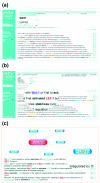Text-mining and information-retrieval services for molecular biology
- PMID: 15998455
- PMCID: PMC1175978
- DOI: 10.1186/gb-2005-6-7-224
Text-mining and information-retrieval services for molecular biology
Abstract
Text-mining in molecular biology -- defined as the automatic extraction of information about genes, proteins and their functional relationships from text documents -- has emerged as a hybrid discipline on the edges of the fields of information science, bioinformatics and computational linguistics. A range of text-mining applications have been developed recently that will improve access to knowledge for biologists and database annotators.
Figures


References
-
- Altavista http://www.altavista.com
-
- Google http://www.google.com
-
- Schuler G, Epstein J, Ohkawa H, Kans J. Entrez: molecular biology database and retrieval system. Methods Enzymol. 1996;266:141–162. - PubMed
-
- Entrez PubMed http://www.ncbi.nlm.nih.gov/entrez/query.fcgi?db=PubMed
Publication types
MeSH terms
Substances
LinkOut - more resources
Full Text Sources
Other Literature Sources

